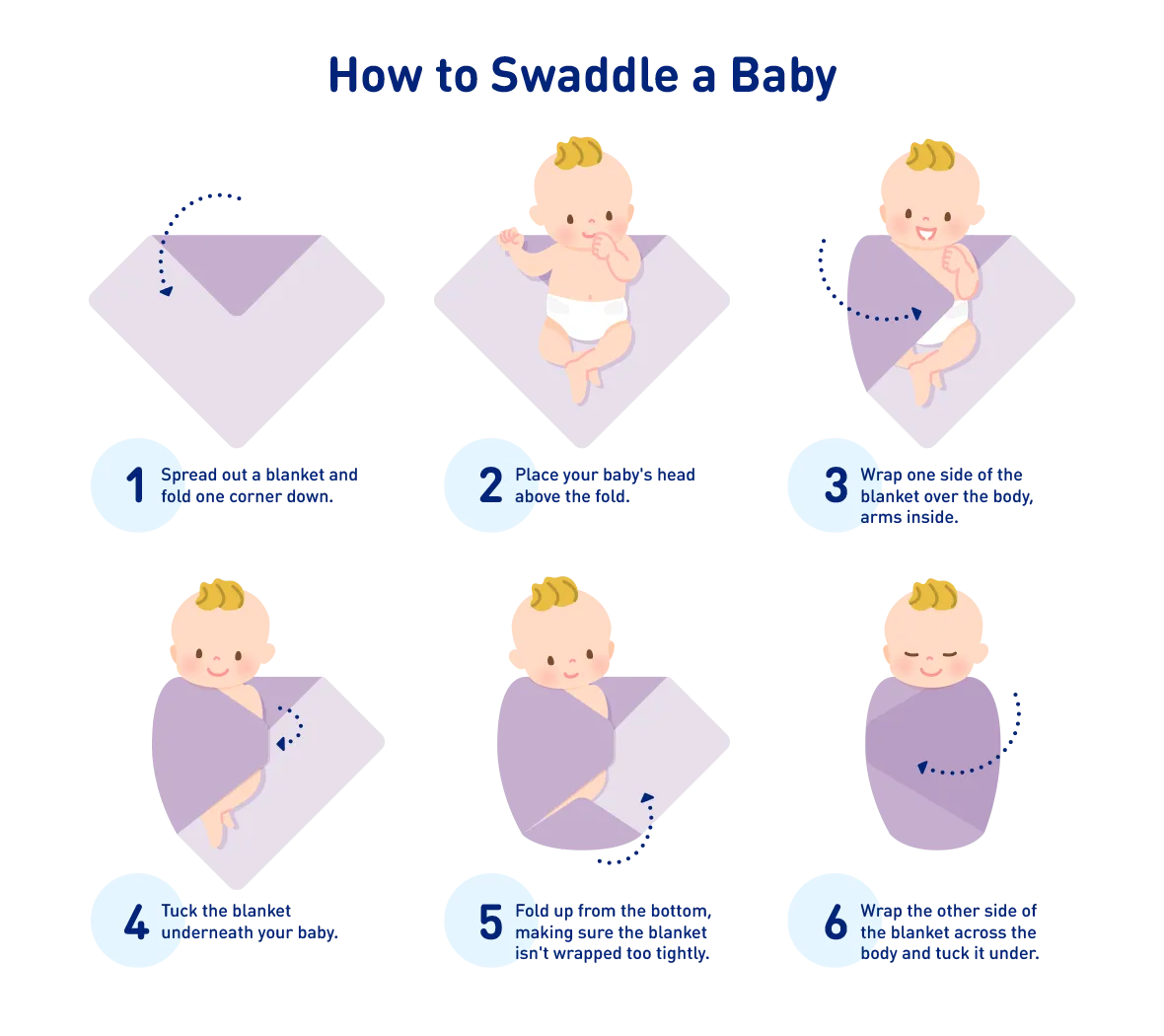Swaddling can calm and comfort your baby. Here are tips on how to do it safely.
Looking for a simple way to calm your baby? Try swaddling. Swaddling is when you wrap a baby gently in a lightweight blanket from the neck down, a bit like a burrito.
Swaddled babies tend to sleep longer and cry less, possibly because they feel secure. Being swaddled helps keep babies from startling themselves awake. It also helps them feel snug and warm like they did in the womb.
If you’re new to swaddling, you may be wondering where to start. Here are some tips on how to swaddle your baby safely. And always reach out to your pediatrician if you need further guidance.
Follow these simple swaddling steps to help calm and comfort your little one.
Choose a lightweight cotton blanket—do not use a weighted blanket. On a flat surface, spread the blanket like a diamond and fold the top down to the bottom corner to form a triangle. As your baby grows, you may only have to fold the top corner slightly.
Lay your baby on their back with their neck and head above the fold at the top of the blanket. Babies should not be swaddled above their shoulders.
Hold one of your baby’s arms against their side, and wrap the blanket around them from one side to the other.
Hold the blanket taut and tuck the extra material from the blanket under their back.
Fold the bottom corner of the blanket diamond up to the baby’s shoulder. Make sure your baby's legs can bend and that the blanket isn't wrapped too tightly.
With your baby’s other arm at their side, wrap the other side of the blanket across the body and tuck it under.
When swaddling, make sure the blanket is taut but not too tight. You should be able to fit two to three fingers between their chest and the blanket. You can also look to your baby for cues: If they look uncomfortable, the swaddle might need to be loosened.
Always lay your baby on their back on a firm, flat surface. Playing some soothing sounds can help them drift off to sleep. Monitor your little one to make sure they don’t roll over while swaddled.


Now that you’ve swaddled your little bundle, enjoy the extra calm a swaddled baby can bring. Still need a little help? Watch the swaddle video above for a tutorial.
If your baby seems comfortable and has enough room for their hips and legs to move, they can be swaddled during sleep time. Don't swaddle them when they are awake and active.
Swaddling is just for newborns. For safety reasons, you should stop swaddling your baby once they show indications they are trying to roll over, such as:
This milestone typically happens between four and seven months but can be as early as two months. Always check with your pediatrician for guidance on when to stop swaddling.
If your baby is ready to transition out of swaddling, here are some methods that may help make the change smoother
Do a one-arm swaddle. Swaddle your baby, but leave one arm out for a couple of weeks. After they have adjusted well to one arm out, try both arms, eventually removing the entire swaddle.
As your baby becomes comfortable with their arms out, consider transitioning to a sleep sack or wearable blanket.
Remove the swaddle at night. Remove the swaddle for your baby’s nighttime sleep, but re-swaddle on their first night waking. Cuddle and soothe them, and as your baby adjusts, you can wean your baby off the swaddling when they wake up.
Once nighttime becomes easier, move on to removing the swaddle at nap time using the same method.
Cold turkey. Remove the swaddle entirely and observe how your baby responds. Some babies are good at self-soothing and will adjust quickly. Other babies may need more time, and a gradual transition using the other methods will be better.
As you try to get your baby to sleep without a swaddle, create a cozy environment conducive to slumber. Turn down the lights, remove any distractions, and consider using a white noise machine. Take it slow and be patient—and as always, reach out to your healthcare provider with any questions.
Swaddling is a safe way to comfort your baby when it is done correctly. It is important to follow the proper guidelines for swaddling and look to your pediatrician for guidance.
Swaddling is unsafe once your baby indicates they are trying to roll over. Always monitor your baby and follow other safe-sleep recommendations:
All information on Enfamil, including but not limited to information about health, medical conditions, and nutrition, is intended for your general knowledge and is not a substitute for a healthcare professional's medical identification, advice, or management for specific medical conditions. You should seek medical care and consult your doctor or pediatrician for any specific health or nutrition issues. Never disregard professional medical advice or delay seeking medical treatment, care, or help because of information you have read on Enfamil.